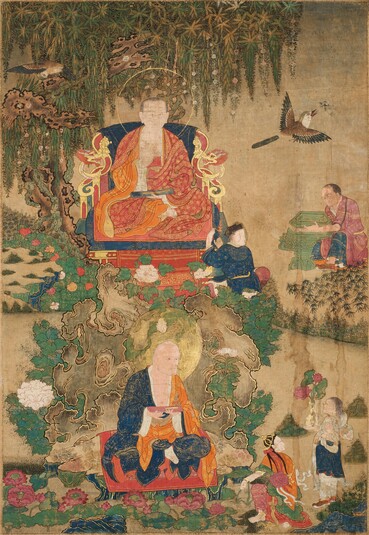
Item: Arhat/Sthavira (Buddhist Elder) - (multiple figures)
| Origin Location | Tibet |
|---|---|
| Date Range | 1600 - 1699 |
| Lineages | Buddhist |
| Material | Ground Mineral Pigment on Cotton |
| Collection | Rubin Museum of Art |
Classification: Person
Appearance: Arhat
Gender: Male
The Two Arhats Pantaka and Gopaka: likely from a set of eleven paintings. (See two paintings of a Maitreya and a Manjushri possibly by the same artist. Also see a selection of details comparing the three paintings).

Pantaka, the Elder (Tibetan: ne ten, lam ten. Sanskrit: Sthavira Pantaka. Wylie Tibetan: gnas brtan lam bstan). The 13th arhat from the set of Sixteen Great Arhats, principal students of Shakyamuni Buddha.
"In the Heavens of the Thirty-three is the noble elder Pantaka, surrounded by 900 arhats; homage to the One [performing] Dharma explication and holding a book." (Sakya liturgical text).
Gopaka, the Elder (Tibetan: ne ten, be che. Sanskrit: Sthavira Gopaka. Wylie Tibetan: gnas brtan sbed byed). The 15th arhat from the set of Sixteen Great Arhats.
"On the king of mountains, Bihula, is the noble elder Gopaka, surrounded by 1,400 arhats; homage to the One holding a book with the two hands." (Sakya liturgical text).
The Sixteen Great Arhats are generally painted as a set. The full group would include the buddha Shakyamuni, the two principal students Shariputra and Maudgalyayana, the sixteen arhats, the attendant Dharmatala, the patron Hvashang and the Four Guardians of the Directions - Vaishravana, Virupaksha, Dritarashtra and Virudhaka. The total number of figures in the composition is twenty-five (25). In the largest sets of paintings each figure is depicted within a single composition except for Shariputra and Maudgalyayana. These two are shown standing to the right and left of the Buddha. In this, the largest set of painted compositions the number of works is twenty-three (23).
The next most common way of presenting the arhats is in a nine painting set. Each arhat is doubled up with another arhat in a single composition. Then, the attendant and patron are each paired with two Guardian Kings making for three figures in the last two of the paintings in the nine painting set. The image above of the painting of Pantaka and Gopaka is likely from a nine painting set.
The arhats can be found in sets of eleven paintings, five, and three compositions. It is also to have Shakyamuni Buddha at the center of a painting with the two principal students, Sixteen Arhats and other figures in a single painted composition.
Jeff Watt 9-2009
Arhat/Sthavira: Gopaka Masterworks
Arhat/Sthavira: Painting Masterworks (Miscellaneous)
Painting Set: Arhats: Two Main Figure Format
Collection of Rubin Museum of Art: Painting Gallery 4
Subject: Glass Vases & Bowls
Arhat/Sthavira: Painting (Bird Examples)
Arhat/Sthavira: Gopaka Main Page
Arhat/Sthavira: Pantaka Main Page
Collection of Rubin Museum of Art: Arhat/Sthavira
Collection of RMA: Persons Masterworks

